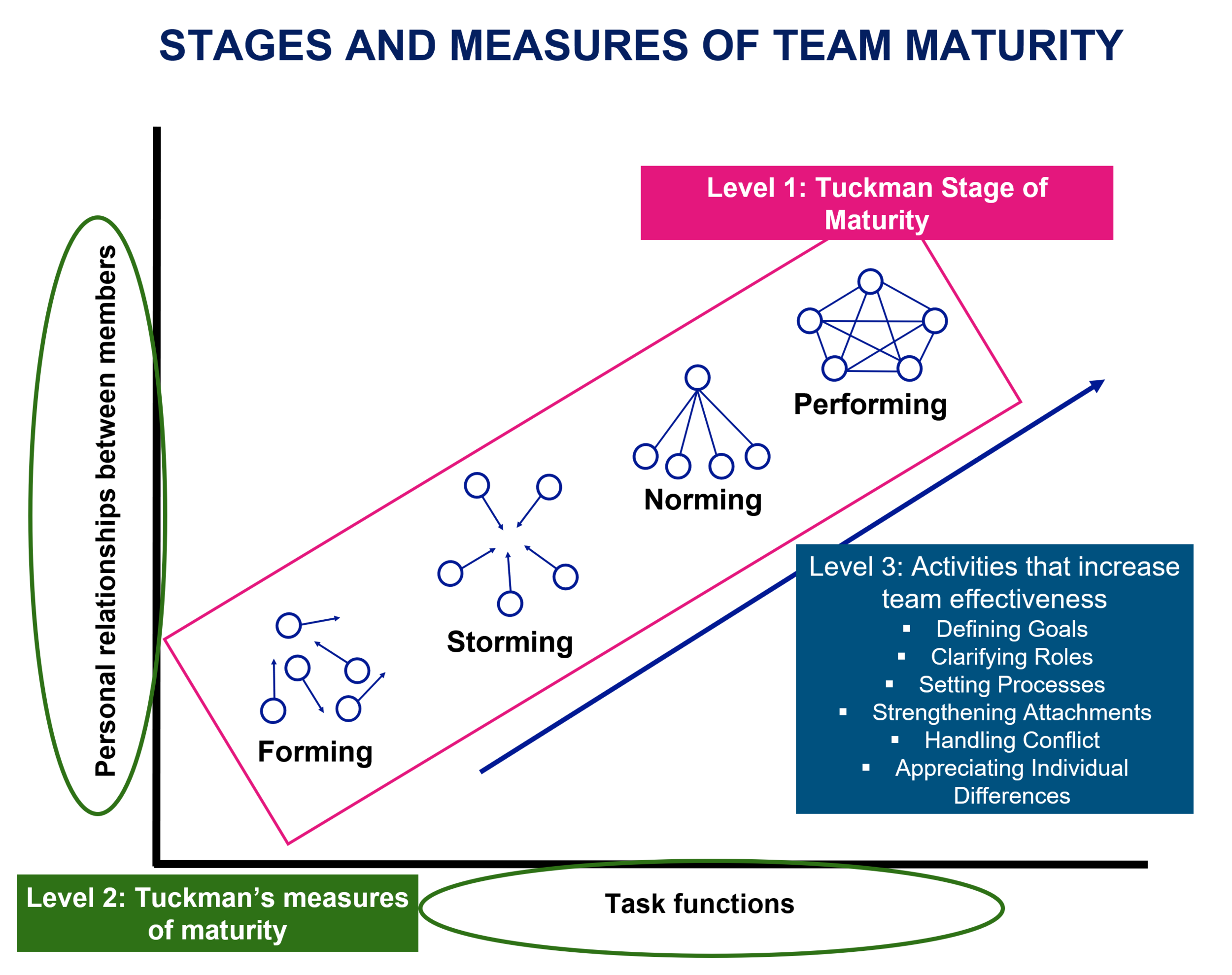Beyond High-Performance: Activities to Increase Team Effectiveness
In our last blog post, we talked about the two dimensions used to measure Team Maturity in Tuckman’s model for team development. This model states that a team can be Forming, Storming, Norming, or Performing depending on how well they execute their Task Functions and handle their Interpersonal Relationships. (See blog post here to read more.)
But after knowing all this information, the question remains… WHAT CAN I DO to develop my team?
This is where our Level 3 Insight will be of value. Using the same analysis introduced in the previous blog posts, we furthered our understanding of what Tuckman’s Assessment can provide. By crafting this 3rd level of insight, we can recommend specific activities that your team can do to increase team effectiveness.
What framework is this Level 3 Insight built on?
We arrived at this list of 6 activities using the following:
The GRPI model first introduced by Richard Beckhard in 1972. GRPI stands for Goals, Roles, Processes, and Interactions. These are the critical aspects of teamwork- meaning, team members must focus on these most critical actions to greater their chances of performance. Because of this model’s popularity in the social sciences, it has been adopted by Six Sigma practitioners and is part of the Six Sigma change acceleration process tool kit.
In Tuckman’s Measures of Team Maturity, Interpersonal Relationships weighed as heavily as Task Functions. Thus, we saw an opportunity to expand the Interactions (the “I”) aspect of the GRPI model to capture the multi-faceted nature of how team members relate with each other.
For interactions in a team to contribute to high-performance, these interactions must not just be taken as random. An environment of psychological safety and open communication must be intentionally crafted. Trust is a key element in building these kinds of interactions (Barczak, et al, 2010). Knowing this, we decided to look into what actions would build trust in a team and came up with these 3 main activities: Strengthening Attachments, Handling Conflict, and Appreciating Individual Differences. These are explained further below.
What are the 6 different activities?
Defining Goals – Goals provide direction and purpose. A good exercise is to ask yourself, “if this team does not exist, what will be missing from the organization?” The answer is a good clue into what your team’s goals should be.
Clarifying Roles – Roles provide clarity. Knowing specializations that exist within the team can make it easier to assign tasks.
Setting Processes – If roles provide clarity on specialization, processes dictate how these different units/members work together to form one integrated system.
Strengthening Attachments – When members have a strong attachment to each other and to their team, belongingness is achieved. This makes it more likely that trust can be built in the team.
Handling Conflict – Teams should not strive for an absence of conflict; rather, you should strive for team members who know what to do when conflict is present. Having the skills of handling difficult conversations, providing feedback, and active listening can help with creating trust in the work environment.
Appreciating Individual Differences – There are many sources of differences – from gender to style to preferences, the list goes on in terms of what can make an individual different from the next. In teams, it is important to harness these individual qualities. This contributes to not just a more diverse environment; but eventually, it also improves team performance and your bottomline.
This shows the complete model of Tuckman’s Stages of Team Maturity. Level 1 Insight shows the stages. Level 2 Insight refers to the measures of maturity. Level 3 Insight gives the activities that teams can do to increase effectiveness.
So, what now?
A common mistake is to go after all 6 activities at once. Yes, they are all important to building a high-performing team. But realistically, you and your members can only focus on a few things at a time. The simpler you can make your initiatives, the easier it will be for people to understand and remember them; thus, there’s a greater chance for behaviors and mindsets to actually change in support of your desired future.
A great way to start is to identify which activity the team is struggling in. Try to find out which one is hindering you from working together to achieve your desired results. You can take our free assessment based on Tuckman’s Stages of Team Maturity to start this identification process.
Communication is key. Team members must know what is going on every step of the way – from the identification of key activities to feedback and maintenance once interventions are implemented. They have to be aware of the current stage, the desired stage, and they journey that all of you will take to get there.
Start your team’s journey to high-performance! Take our Team Maturity Test at
https://www.teamjourneys.com/discover
Sources:
Aron, A., Melinat, E., Aron, E. N., Vallone, R. D., & Bator, R. J. (1997). The experimental generation of interpersonal closeness: A procedure and some preliminary findings. Personality and Social Psychology Bulletin, 23(4), 363-377.
Barczak, G., Lassk, F., & Mulki, J. (2010). Antecedents of team creativity: An examination of team emotional intelligence, team trust and collaborative culture. Creativity and innovation management, 19(4), 332-345.
Carlock, R. S. (2012). Assessment tools for developing and leading effective teams. Working paper no. 49811, INSEAD, Singapore.
Fraser-Thill, R. (2019). Belonging at work is essential – here are 4 ways to foster it. Forbes. Retrieved Oct. 26, 2019 from https://www.forbes.com/sites/rebeccafraserthill/2019/09/16/belonging-at-work/#1976e434ab83
Gompers, P. & Kovvali, S. (2018). The other diversity dividend. Harvard Business Review. Retried Oct 26, 2019 from https://hbr.org/2018/07/the-other-diversity-dividend
Han, G., & Harms, P. D. (2010). Team identification, trust and conflict: A mediation model. International Journal of conflict management, 21(1), 20-43.
Rubin, I. M., & Beckhard, R. (1972). Factors influencing the effectiveness of health teams. The Milbank Memorial Fund Quarterly, 50(3), 317-335.
Tuckman, B. W. (1965). Developmental sequence in small groups. Psychological bulletin, 63(6), 384.

